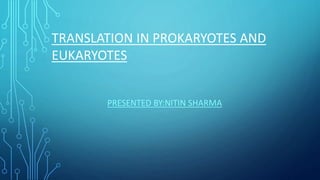
Translation in prokaryotes and eukaryotes
- 1. TRANSLATION IN PROKARYOTES AND EUKARYOTES PRESENTED BY:NITIN SHARMA
- 2. CONTENTS Introduction Translation in Prokaryotes Translation in Eukaryotes
- 3. INTRODUCTION TO TRANSLATION Translation of mRNA is the biological polymerization of amino acids into polypeptide chains. Triplet codons of mRNA direct specific amino acids into their correct position in the polypeptide. Transfer RNA (tRNA) class of molecules adapts genetic information present as specific triplet codons in mRNA to their corresponding amino acids. A specific tRNA molecule contains within its nucleotide sequence three consecutive ribonucleotides complementary to the codon called the anticodon
- 5. LARGER SUBUNIT SMALLER SUBUNIT LARGER SUBUNIT SMALLER SUBUNIT 23S rRNA (2904 nucleotides) + 5S rRNA (120 nucleotides) + 31 proteins 16S rRNA (1541 nucleotides) + 21 proteins 28S rRNA (4718 nucleotides) + 5S rRNA (120 nucleotides) + 5.8S rRNA (160 nucleotides) + 46 protein 18S rRNA (1874 nucleotides) + 33 proteins Prokaryotes Monosome 70s Eukaryotes Monosome 80s
- 6. STEPS OF TRANSLATION Translation proceeds in four phases Activation Initiation Elongation Termination
- 7. ACTIVATION In activation the correct amino acid is covalently bonded to the correct tRNA also called charging of tRNA Occurs under the direction of enzymes called aminoacyl tRNA synthetases. The amino acid joined by its carboxyl group to the 3 OH of tRNA by the help of ATP When tRNA is attached to its respective amino acid it is said to be “charged”
- 8. INITIATION Prokaryotic initiation requires the small ribosomal subunit, an mRNA molecule, a specific charged initiator tRNA, GTP, Mg2+, and three proteinaceous initiation factors (IFs) that enhance the binding affinity of the various translational components The small ribosomal subunit binds to several initiation factors and this complex in turn binds to mRNA In bacteria, this binding involves a sequence of upto to six ribonucleotides (AGGAGG that precedes the initial AUG start codon of mRNA.This sequence —containing only purines and called the Shine–Dalgarno sequence Another initiation protein then enhances the binding of charged formyl methionyl tRNA to the small subunit in response to the AUG triplet In whole step a molecule of GTP is released providing energy and initiation factors are released
- 10. ELONGATION With the formation of 70s initiation complex the elongation cycle begins It requires elongation factors EF-Tu,EF-Ts and EF-G and GTP Once both subunits of the ribosome are assembled with the mRNA, binding sites for two charged tRNA molecules are formed. These are the P (peptidyl) site and the A (aminoacyl) site. The charged initiator tRNA binds to the P site, provided that the AUG codon of mRNA is in the corresponding position of the small subunit. The sequence of the second triplet in mRNA dictates which charged tRNA molecule will become positioned at the A site The covalent bond between the tRNA occupying the P site and its cognate amino acid is hydrolyzed (broken).The newly formed dipeptide remains attached to the end of the tRNA still residing in the A site The tRNA attached to the P site, which is now uncharged, must be released from the large subunit. The uncharged tRNA moves briefly into a third site on the ribosome called the E (exit) site The entire mRNA–tRNA–aa2–aa1 complex then shifts in the direction of the P site by a distance of three nucleotides. This event, called translocation, requires several protein elongation factors (EFs).
- 12. TERMINATION The process is signaled by the presence of anyone of the three possible triplet codons appearing in the A site: UAG, UAA, or UGA. These codons do not specify amino acid, nor do they call for a tRNA in the A site They are called stop codons, termination codons, or nonsense codons. The termination codon signals the action of a GTP dependent release factor, which stimulates steps leading to the release of the polypeptide chain from the terminal tRNA and subsequently from the translation complex The tRNA is released from the ribosome, which then dissociates into its subunits
- 13. TRANSLATION IN EUKRYOTES Translation in eukaryotes is much more complex as compare to prokaryotes In eukaryotic cells transcription occurs in the nucleus and translation in the cytoplasm. Three differences center on the mRNA that is being translated. First, the 5 end of mRNA is capped with a 7-methylguanosine (7-mG) residue at maturation Many mRNAs contain a purine (A or G) three bases upstream from the AUG initiator codon, which is followed by a G (A/GNNAUGG) called kozak sequence Eukaryotic mRNAs require the posttranscriptional addition of a poly-A tail on their 3 end; that is, they are polyadenylated.
- 15. INITIATION Initiation of translation in eukaryotes requires 10 initiation factors A ternary complex containing met Trna and eIF-2 bound to gtp and attaches to 40s ribosome subunit to form 43s preinitiation complex Eif-3 and Eif-1A stabilizes this complex mRNA binds to 43s preinitiation complex result in formation of 48s initiation complex 48S initiation complex binds to 60s ribosomal subunit to form 80s initiation complex.
- 16. ELONGATION Elongaton requires the use of the elongation factors EF-1a and supply of energy by GTP Translocation requires EF-2 and GTP GTP get hydrolysed and supplies energy to move mRNA
- 17. TERMINATION One of the stop signals (UGA UAA AND UAG) terminates the growing polypeptide In eukaryotes Erf1 recognize all three stop codons and Erf3 stimulate the termination events Release factor binds and ribosomal unit falls apart releasing the large and small subunit
- 18. POST TRANLATIONAL MODIFICATION The N-terminus amino acid is usually removed or modified Carbohydrate side chains are sometimes attached Signal sequences are removed Polypeptide chains are often complexed with metals